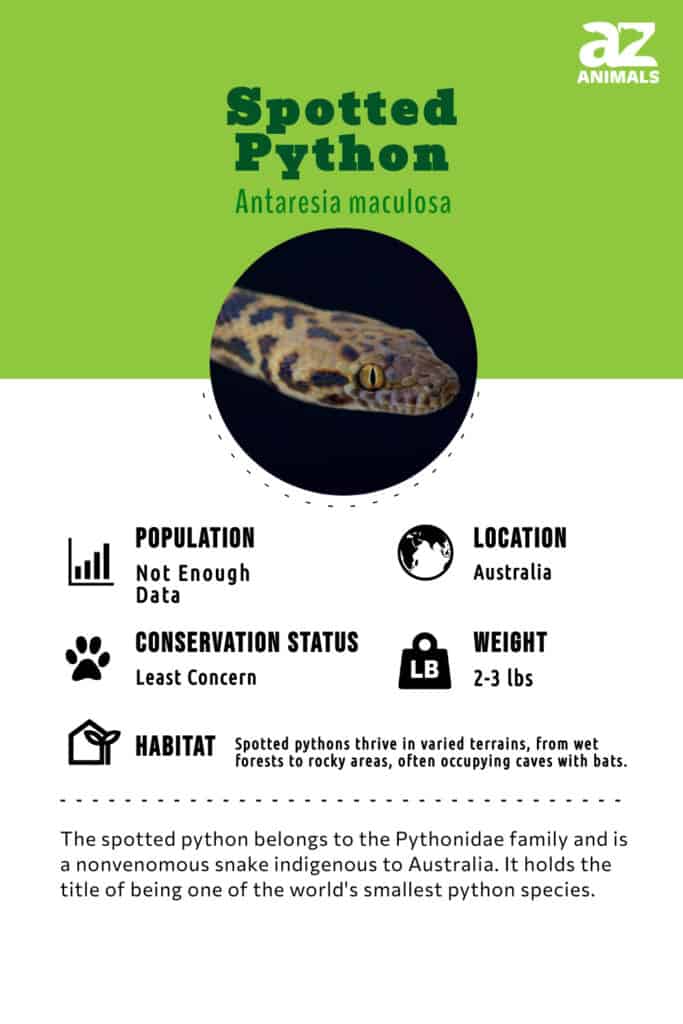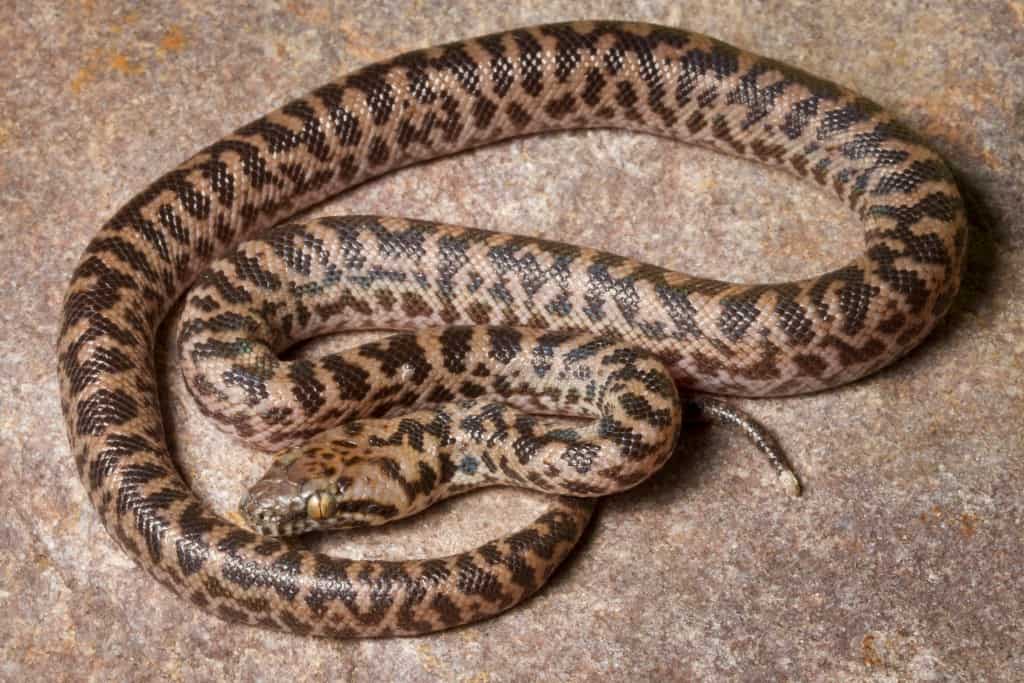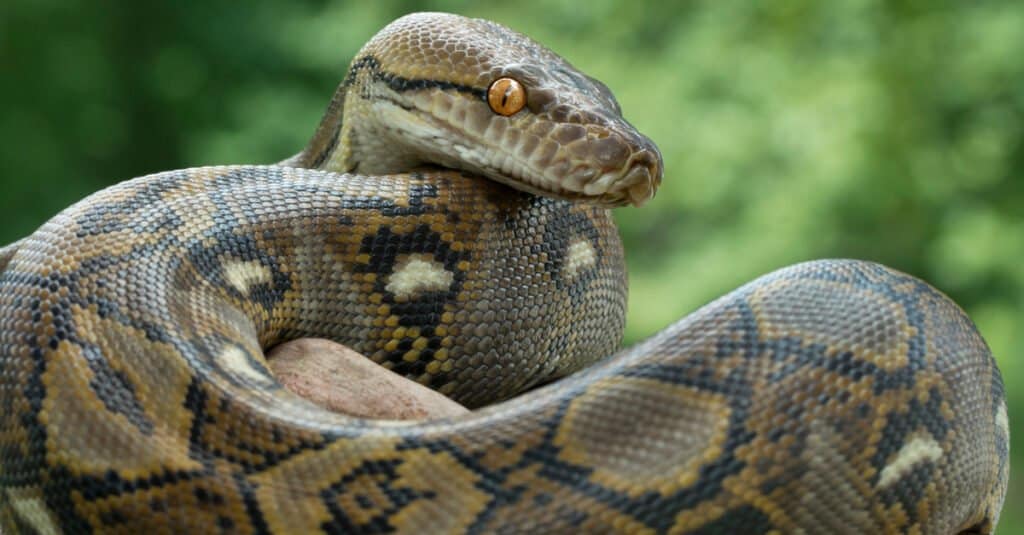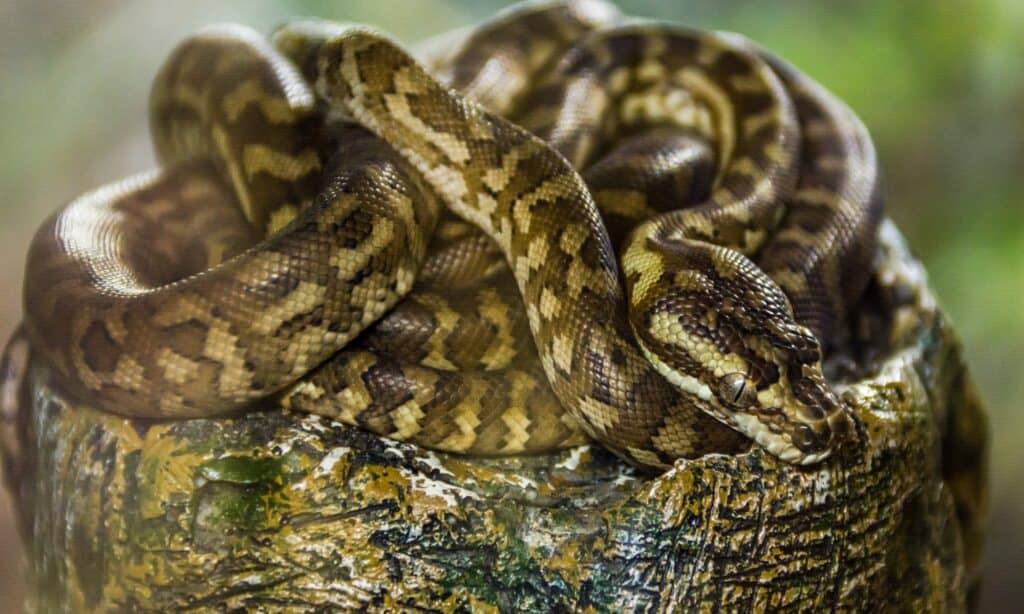Spotted python
Antaresia maculosa
Their favorite food is bats and they hang from cave entrances to snatch them out of midair!
Advertisement
Spotted python Scientific Classification
- Kingdom
- Animalia
- Phylum
- Chordata
- Class
- Reptilia
- Order
- Squamata
- Family
- Pythonidae
- Genus
- Antaresia
- Scientific Name
- Antaresia maculosa
Read our Complete Guide to Classification of Animals.
Spotted python Conservation Status
Spotted python Facts
- Prey
- Insect-eating bats, mice, rats, geckos
- Main Prey
- Insect-eating bats
- Name Of Young
- Hatchling, neonate
- Group Behavior
- Solitary except during mating season
- Fun Fact
- Their favorite food is bats and they hang from cave entrances to snatch them out of midair!
- Other Name(s)
- Eastern small-blotched python, eastern children's python
- Litter Size
- 10-25
- Lifestyle
- Nocturnal
- Favorite Food
- Bats
View all of the Spotted python images!

The spotted python is one of the smallest pythons in the world, and a nonvenomous snake native to Australia in the family Pythonidae.
This snake’s spots are irregular and sometimes merge into bands or stripes. It’s part of the Children’s python group, and some keepers believe that most of the snakes bred and kept in captivity are spotted pythons.
Amazing Facts About Spotted Pythons

Spotted pythons’ spots are irregular and have rough edges.
©iStock.com/reptiles4all
- This is the biggest snake in the Antaresia genus and sometimes reaches six feet long. Snakes in the Antaresia genus are some of the smallest pythons.
- These pythons are very adaptable and live in most habitats within their range.
- Spotted pythons sometimes hang from cave entrances to catch bats as they fly by.
Where to Find Them

A. maculosa has more defined spots than A. childreni.
©iStock.com/David Kenny
Spotted pythons inhabit Australia from the Cape York Peninsula south through eastern Queensland and northern New South Wales. They also inhabit many of the islands off Queensland’s coast and some southern areas of Papua New Guinea.
These snakes prefer rocky hillsides and outcrops for shelter, they’re semi-arboreal, so you’ll find them in the trees nearly as often as on the ground. Spotted pythons are highly adaptable and live in most habitats. You’ll often find them in forests, savanna, shrubland, freshwater wetlands, grassland, plantations, and pastures.
Diet and Hunting Habits
Juveniles eat small lizards until they’re big enough to take larger prey. Adult spotted pythons often hang from the entrances of caves by their tails to catch their favorite prey, bats, as they fly by. While these snakes are partly arboreal, it’s the juveniles that spend the most time in the trees. Adults spend more time on the ground. They also eat geckos, mice, and other small mammals; and in captivity often accept rodents without any problems.
Reproduction
Scientists don’t know much about their mating practices in the wild. However, breeders say that they’re easy to keep and lay between 10-20 eggs at a time. If allowed to do so, the female stays wrapped around the eggs until they hatch, about 7-8 weeks later. During the incubation period, the mother occasionally shivers to increase the temperature and protects the clutch from predators. When babies hatch, they measure from 10-20 inches and reach maturity in about three years.
Evolution and Origins
Originating from Africa, Asia, and Australia, numerous python species have made their journey to the United States due to their popularity in the pet trade. While the pet trade can bring rare snakes into the west, what about where spotted pythons are found to begin with?
Originally, spotted pythons inhabit Australia’s northeastern to eastern coastal region, spanning from Queensland’s Cape York to northern New South Wales. They thrive in environments ranging from wet forests to dry woodlands, favoring riverbanks and rocky locations, often dwelling within bat-inhabited caves.
Irrespective of their length, pythons exhibit a robust build. With triangular heads and sharp, rear-curving teeth, they employ these attributes to seize their prey.
Scientific Name
As of 2020, there are two subspecies of spotted python – A. maculosa maculosa and A. maculosa peninsularis. There are four species in the genus Antaresia, including the spotted python. This genus got its name from the star Antares (which means anti-Ares, a reference to the planet Mars), a red giant star in the constellation Scorpio. Their specific name, maculosa, means spotted. They are also called eastern small-blotched python, and eastern Children’s python.
Different Types
- Burmese python
- Indian python
- Pygmy python
- Antaresia
- Antaresia stimsoni
- Pythons
- Woma python
- Morelia spilota cheynei
- Python brongersmai
- Water python
- Morelia spilota mcdowelli
- Morelia spilota imbricata
- Oenpelli python
Population and Conservation Status
According to the IUCN Redlist of Threatened species, spotted pythons have a stable population with a large distribution in northeastern Australia. Its adaptable nature allows it to leave in a wide range of habitats, including populated areas.
It’s unlikely that the snake will face any major threats because it inhabits several protected areas and is very common. The Convention on International Trade in Endangered Species of Wild Fauna and Flora (Cites) listed the spotted python under Appendix II, thereby preventing some international trade.
Australia banned the export of these and other native animals in 1999 with the passing of the Environmental Protection and Biodiversity Conservation Act. What that means is that if it’s not out in the world with breeders at this point, it likely won’t be any time soon – at least not legally. Happily, enough of these snakes were exported before the EPBCA passed and are bred pretty widely and easily kept.
Appearance and Description

The reticulated python can grow to 30 feet and has been spotted mainly in southern and southwestern counties of Florida but also in Tampa and on the Georgia border.
©Mark_Kostich/Shutterstock.com
These relatively slender pythons are almost dainty compared to their larger cousins, even ball pythons with similar lengths look downright chunky in comparison. Spotted pythons have elliptical pupils with eye colors that match the colors surrounding their eyes, and many have a dark stripe that begins near their nose and continues through their eyes towards their jaw. Like most pythons, these snakes have heat-sensing pits that help them locate warm-blooded prey.
The scales on spotted pythons’ bodies are small, smooth, and slightly overlapping. Those on their heads are symmetrical and large, and their bellies are often cream-colored with a few spots here and there. The base color is tan to light brown overlayed with darker spots. Their spots do not have clean edges and look a bit ragged around the edges and they’re more pronounced than those of the Children’s python.
There aren’t any consistent morphological differences between A. maculosa peninsularis and A. maculosa maculosa, the differences are found within a few nucleotide substitutions in their genetic makeup.
How Dangerous Are They?
This is not a dangerous snake. Spotted pythons are small nonvenomous constrictors that are, like other snakes, rodent control. They are not aggressive and are far more likely to run, well, slither away. A bite from one of these might hurt, but they’re so small that they might not even draw blood. Even if a spotted python does draw blood, you’ll be fine unless you don’t keep it clean and it becomes infected. In which case, seek medical care.
Behavior and Humans

This species loves to climb and is only 5-6 feet long if it’s really big.
©iStock.com/seakitten
These snakes adapt extremely well to various habitats, including those that people create. They breed easily and aren’t under any specific threats.
You probably won’t find any wild-caught specimens of these wonderful little snakes outside of Australia (or you shouldn’t) because of the EPBCA. However, there are enough breeders worldwide who were able to obtain one before Australia banned their export, so it’s pretty generally pretty easy to find one from a reputable breeder.
Spotted pythons are popular pets because they stay relatively small and usually have docile temperaments; but also because it’s easy to provide them with an appropriate enclosure. Thanks to its wide temperature and humidity tolerances, it’s a great beginner snake.
Some individuals can be a little bitey, especially juveniles, but many grow out of that with regular handling.
View all 293 animals that start with SSpotted python FAQs (Frequently Asked Questions)
Are spotted pythons dangerous?
No! Like all pythons, they’re nonvenomous, and they are too small, even as adults, to do any harm to you.
Where do spotted pythons live?
This species lives in east and northeastern Australia.
What do spotted pythons eat?
Nearly all snakes are excellent rodent control, and this species is no exception. They eat mice, rats, lizards, and geckos, but their favorite food is bats.
How do spotted pythons hunt?
Most of the time, they wait and ambush their prey. Sometimes, the snakes take a more active role and hang from cave entrances to catch bats.
Thank you for reading! Have some feedback for us? Contact the AZ Animals editorial team.
Sources
- Spotted Python | Reptile Database / Accessed June 8, 2022
- Spotted Python | IUCN Redlist of Threatened Species / Published June 12, 2017 / Accessed June 8, 2022
- Antaresia.com / Accessed June 8, 2022
- Australia's Dwarf Pythons - Genus Antaresia | Raymond T. Hoser / Published June 1, 1999 / Accessed June 10, 2022


















